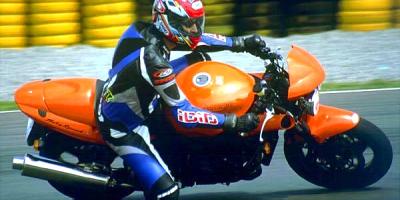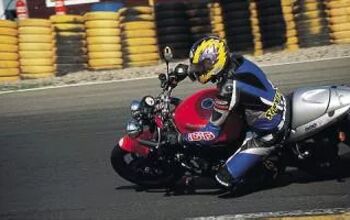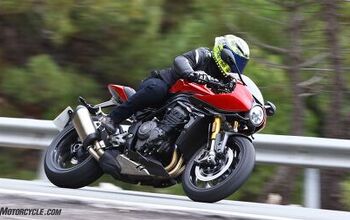First Ride: Triumph Speed Four - Motorcycle.com
Italy, July 2, 2002 -- Quite a few years ago I came across a nifty little book called "Designing Design." Its author, a respected design lecturer, suggested in it a strange process: letting chance and the unexpected steer you towards new concepts and solutions. After all, weren't some old, mold-filled petri dishes what brought Fleming to the discovery of penicillin? And in our beloved two-wheeled field, didn't MZ's Walter Kadden discover a 20-percent increase in power when he made a third transfer port in a two-stroke engine that was only meant to cool and lubricate the small end bearing in the first place?
So how about dropping your new crotch rocket in the parking lot, messing up all the plastic, only to find out that your MasterCard is maxed out, ruling out proper repairs?
Can't it be turned into a win-win situation? Why not save the dosh and build a mean'n'light streetfighter? Well, the approach has worked extremely well for Triumph, at least with the Speed Triple - essentially a Daytona sans fairing. Its bold, "freshly crashed" looks have endeared it to the hearts of many enthusiasts that'd been growing tired of all those smooth and "designed" fairing panels, a real punk in disco-land. The kinky Speed Triple has become a bit of a cult object with its distinctive bug-eyed hooligan pose, a virtue that other company's marketing guys would be happy to sell their sisters for.
Recently, the question was whether or not the same trick could work on little bro' TT600. And the answer is yes, at least functionally speaking. Last year I had the chance to sample the prototype Speed Four at a track and couldn't stop giggling for a week. The excellent handling manners of the chassis were as good as a CBR600s, orchestrated by wide and flat bars and an engine that thrives on gearshift lever tap dancing. That prototype Speed Four was an absolute adrenaline pump on the track. (Made me also understand why so many crazy Germans fit straight bars to 'Busas and ZX9s.) Trouble was that, in the looks department, that early naked 600 left a lot to be desired. The carbon cover on the radiator's left side and the twin black elephant snouts/air intakes looked a bit homemade and the bare aluminum castings of the engine almost scratched my eye's retinas.
In any case, Triumph picked away at the original idea of the Italian importer, and proper designers that haven't read "Designing Design" were put to work. Ah! Much, much better! That little g-string bikini fairing that the Speed Triple lost for 2002 has been put to work on the Four and aggressive, shorter and color-matched snouts replace the previous ones and the frame and engine are painted matte black. The result is a much more homogeneous looking tool, and the contrast between the black mass of the engine/frame and the bright candy orange body parts is pretty exciting.
There have been mechanical changes, too. The cast, semi-dropped handlebars of the TT600 remain in place (the prototype had flat tubular bars) and the engine has been detuned for more usable torque. Peak power is down, from a claimed 108 to 97. These two changes saddened me somewhat. Straight tubular bars are fun and easy to replace when your stand-up wheelies go wrong (not that I am any good with 'em...) while engine de-tunes always arise suspicion. Are we really going to get that midrange bulge for the horses we traded up there? One thing is sure; as I pull into the track on the Four, I can't help but notice that the new, mid-range minded valve timing seems to have cured the last injection gremlins of this engine. The engine pulls now as cleanly as in any of the last crop of Japanese 600's.
"Four is utterly flickable, there's abundant ground clearance and you feel at home using all of it immediately."
On a track, I don't spend too much time doing roll-ons. Revs get kicked in no time into the upper range, but on the retuned Four there is a less of a need to wait for 10,000 to show on the tacho to get the engine on the boil as with the TT600. Pulling out of turns, even from as low as 7,500 rpm, the Four moves on swiftly while, on the other hand, there is less of an R6-like urgency near red-line. It's very much like comparing the old CBR900RR engine to the one in the new 919 streetfighter. On the track I kinda miss the upper-range rush of the prototype, but on the street the retuned motor should provide a much better balance for everyday, lower speed use.
What haven't changed are the impeccable wicked road manners of the cycle portion. The Four is utterly flickable, there's abundant ground clearance and you feel at home using all of it immediately. Just as on a big-H product, you have instant confidence. I haven't had too much time or need to play with suspension settings as the standard ones felt OK with nice absorption even when I was unfairly cutting up on people in the chicanes, riding the curbs. The standard issue TT600 bars are a mixed blessing. Gone is the ample leverage of the wide and flat bars, but on faster bends, the lower crouch comes into its own, supplying greater precision and reducing wind blast on your torso.
Nevertheless, for its intended use as an everyday hooligan tool or while using the excellent anchors to the max, I still feel that the flat bars were a better choice as they put less stress on your wrists. The unchanged ergos of the TT600 never were a big hit and at least the previous prototype offered some improvement. If you are a sloppy beast like me, change is just a matter of taking the handlebar mounts from the old Maico in the garage, drilling by eye two 5/16" holes on the upper triple clamp, fit some K&N superbike bend bars and hey, presto! Full hooligan pose restored. Still on the issue of nitpicking, on such a streetfighter I'd rather have lower gearing, too. High speeds are not an issue with this kind of bike anyway, and the extra pull could be useful for those Garry Rothwell antics and to impress your friends on roll-ons.
"After two turns on the track, I was giggling again. The S'Four is a true scratchers tool, amazingly efficient on a track and the enhanced mid-range is really welcome."
It's hard to pinpoint what makes riding a fairing-less sportbike so much more exciting than riding a normal crotch rocket, but the magic is there. Maybe its just the fact that it looks, well... so damn different than your run of the mill 600. Maybe it's a wind-in-your-face thing making you feel like you are moving a lot faster than you actually are. Or maybe you need to ask any Speed Triple owner for a better explanation.
The last Euro-crop of naked 600s, namely Honda's Hornet 600 and Yamaha's Fazer 600, has bypassed the US, but there is no more need to cry dear brothers and sisters. The US-bound Speed Four is a much more entertaining bad-boy tool. The two Japanese contenders, although big hits in Europe, have steel frames and their handling manners are not in the Speed Four's league. With all due respect, the Speed Four didn't make me salivate compulsively at it's sight as the hairy-chested Speed Triple did, but then, at 7,499$ its 2K cheaper than its big brother. With so much street cred being heaped on the Speed Triple, there is no reason why the Speed Four will not be following in its footsteps.
| **Specifications** | |
| Engine | |
| · Type | Liquid-cooled, DOHC, in-line 4-cylinder |
| · Capacity | 599cc |
| · Bore/Stroke | 68 x 41.3 mm |
| · Compression Ratio | 12.5:1 |
| · Fuel System | Multipoint sequential EFI with forced air induction |
| · Ignition | Digital- inductive type - via electronic engine management system |
| Transmission | |
| · Primary | Drive Gear |
| · Final Drive | X-ring chain |
| · Clutch | Wet multiplate |
| · Gearbox | 6-speed |
| Cycle Parts | |
| · Frame | Aluminium beam perimeter |
| · Swingarm | Twin-sided, aluminium alloy |
| · Front Wheel | Alloy 3-spoke, 17 x 3.5in |
| · Rear Wheel | Alloy 3-spoke, 17 x 5.5in |
| · Front Tyre | 120/70 ZR 17 |
| · Rear Tyre | 180/55 ZR 17 |
| · Front Suspension | 43mm forks with dual rate springs and adjustable pre-load, compression and rebound damping |
| · Rear Suspension | Monoshock with adjustable pre-load, compression and rebound damping |
| · Front Brakes | Twin 308mm floating discs, 4-piston calipers |
| · Rear Brakes | Single 220mm disc, single-piston caliper |
| Dimensions | |
| · Length | 2060mm (81.1in) |
| · Width | 690mm (27.2in) |
| · Height | 1150mm (45.3in) |
| · Seat Height | 810mm (31.9in) |
| · Wheelbase | 1395mm (54.9in) |
| · Rake/Trail | 24.6 degrees/ 89.1mm |
| · Weight (Dry) | 170kg (374lb) |
| · Fuel Capacity | 18 litres (4.7 gal US) |
| Performance (Measured to DIN 70020) | |
| · Claimed Maximum Power | 98PS (97bhp) at 11,750 rpm |
| · Claimed Maximum Torque | 68Nm (50.5ft.lbf) at 10,500 rpm |
More by Yossef Schvetz































Comments
Join the conversation